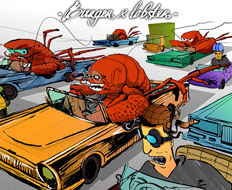Restaurant models are generally imperfect. Ninety-nine percent of the time there are clear negatives to every model.
As an example, let’s talk about the traditional model for a coffee business. The percentage margins are high and the staffing costs are low—two great indicators for success—but in order to make any meaningful profit, you need to drive high volume and own multiple outlets. This is due to the fact that, despite percentage margins being high, the cash margin is low. If you make 20 percent profit on a $2 cup of coffee (after cost of labor, rent, custom cups, marketing, and other operational expenses), you are making 40 cents per cup. You’ll need to sell a ton of coffee for those 40 cents to add up to a meaningful profit annually.
This is the major challenge for almost all quick-service businesses: They are capitally intensive because they need to open a lot of outlets and have to eke out small margins over a large volume of business. Additionally, when looking at a model like coffee, the post–6 p.m. meal period is rarely profitable because most people prefer to spend their nights sleeping rather than rolling around in bed with their mind racing on caffeine. Despite these challenges, the coffee business is clearly one of the top business models in the world today.
But I think I have found one even better—maybe even perfect.
CLOSER LOOK
Burger & Lobster
OWNERSHIP: Goodman Restaurants, George Bukhov & Partners
LOCATIONS: 4
WHERE: London
SIGNATURE ITEMS: Gourmet Burgers, Lobster Rolls, and Whole Lobsters
Over the past few months, I have been spending a lot of time researching the market in London and have come across a curious phenomenon: the hyper-focused, high-end restaurant. Born out of the American food-truck craze and the renaissance of London’s food culture, upscale restaurants are highly focused on specific items, specifically gourmet versions of classic quick-serve fare. Some examples include Bubbledogs, a restaurant serving only champagne and hot dogs; Meat Liquor, which is focused on burgers, barbecue, and bourbon; and Duck & Waffle, a 24-hour restaurant from the group behind
SushiSamba serving an upscale take on chicken and waffles. But far and away the “mother ship” of this trend is Burger & Lobster, created by Russian-born George Bukhov.
Burger & Lobster has four locations in London and has expanded rapidly since its opening in 2012. The concept is simple: decadent burgers on brioche buns; large, sweet lobster rolls; and high-quality whole lobsters from the company’s 2.5-ton lobster tank located below the restaurant. The restaurants all have generously sized bars serving inventive cocktails and accompany their specialties with french fries or a salad. On my last visit to the Dean Street location at 7 p.m. on a Thursday, there was a two-hour wait to sit down and eat. Even more impressive than the wait was the spectrum of customers waiting. Classic Motown tunes blared over the speakers while customers ranging from London hipsters to bankers and Japanese tourists—young and old alike—drank boatloads of liquor and draft beer while happily oblivious to the wait time.
By combining one of the most popular foods in the world (burgers) with a known luxury item (lobsters), Bukhov has created what I call a “simple indulgence.” Similar to a Magnolia Bakery cupcake or Louis Vuitton keychain, a meal at Burger & Lobster provides the customer with satisfaction and aspiration at a cost that is attainable to almost everyone. Bukhov has clearly found a sweet spot in the London market, but what makes Burger & Lobster so impressive are the nuts and bolts of the model. The restaurant serves more than 1,000 customers on a Saturday night. The only items it serves are burgers, lobster rolls, whole lobsters, and drinks. This makes it much easier for an operator to control quality, consistency, and cost. By combining these four items with high volume and high-quality management and marketing, you create an incredibly efficient and profitable model. Burger & Lobster sells everything on the menu for 20£ ($30), unless you get one of the “big boy” lobsters. So if you assume a conservative 15 percent margin, it is making $4.50 on every plate that goes out, excluding alcohol sales, which should have at least a 20–25 percent margin.
The incredibly simple idea behind Burger & Lobster brings together the holy trinity of restaurant success: high volume, high cash margins, and a limited offering, alongside massive alcohol sales. Whether through strategic genius or a happy accident, Bukhov may have cracked the code on the perfect restaurant model and taken the baton from Shake Shack to further pave the way for “luxury quick service”—quite possibly the most profitable segment in the restaurant business today.








